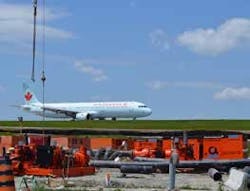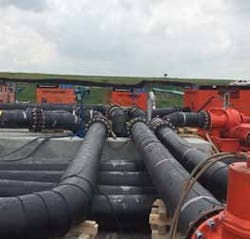Sewage Bypass Canada’s Largest Bypass Project Lands at Canada’s Largest Airport
Canada’s Region of Peel is a permanent home to more than 1 million people and a temporary stopover for another 20 million air travelers who pass through Toronto Pearson Airport each year.
Those numbers add up to make Peel Region the second largest province in Ontario, and Toronto Pearson the busiest airport in all of Canada. They also added a high level of complexity to a recent wastewater construction project, which Atlas and Xylem teams solved with an equally intricate bypass solution.
To engage in ongoing reconstruction and development of their sanitary sewers and manholes, Peel Region needed to finish a significant infrastructure connection under the airport runway. This involved the twinning of the Etobicoke Creek Trunk Sanitary Sewer line to provide system redundancy.
Adding to the challenge, the entire project had to be done without interruption to airport operations. To make that possible, work crews were in constant contact with airport personnel, including daily security clearances for staff and equipment, and maintained a minimum eight-meter Runway Object Free Area for worker safety.
The primary 1,800-milimeter (mm) sanitary sewer line at Etobicoke Creek feeds into two smaller lines – 1,650 mm and 1,200 mm in diameter – via a splitting chamber. (In non-metric terms, these lines are 71 inches, 65 inches and 47 inches, respectively.) As part of the reconstruction effort, each of these lines had to be temporarily diverted to allow access for valve upgrades, manhole work, and connection to the new twinned sewer line and chambers.
Solution
The first phase of the bypass project involved plugging the 1,200 mm line to provide access for the work crews. The Atlas team used an inflatable mechanical dome-style sewer plug, air hose and air regulator, which diverted flow to the 1,650 mm line. The plug was in place for approximately 30 days, and the bypass – which was gravity-fed and required no pumps or piping – functioned without a problem.
The next phase was trickier because the team had to divert flow from the bigger 1,650 mm line to the narrower 1,200 mm line to allow for reconstruction efforts on a 300-meter (327 yards) section of the pipe. The Atlas team again installed an inflatable mechanical plug, and like phase one, the bypass was completely manual and gravity-fed. However, since there was potential for increased flow from the larger line to overwhelm the smaller in a severe weather event, Atlas installed four backup Godwin diesel-driven, critically silenced CD400M Dri-Prime pumps to handle the possible extra flow.
“We needed the bypass to handle the daily flow, but it also needed to handle any extreme weather events,” says Jason Bunston, Sales Manager for Atlas Dewatering Corporation, the local distributor for Xylem’s Godwin and Flygt-brand pumps. “Having the extra capacity designed into the plan was reassuring, giving us all some added peace of mind.”
Like part one of this project, this second phase also ran for approximately 30 days without a hitch. While the back-up pumping plan let everyone breathe easier during the month-long diversion, it was never needed, which saved Peel a significant amount of money.
The final phase featured construction of a bypass line that could handle the 85 million gallons per day (MGD) of flow from the primary 1,800 mm trunk. For this job, Atlas mobilized 11 rented Godwin diesel-driven, critically silenced CD400M Dri-Prime pumps with 18-inch capacity. Ten of the pumps were utilized as the primary pumping mechanism and the last one was put in place as the redundant back-up.
To save energy and diesel fuel costs, each pump was equipped with a Godwin Level Transducer that would trigger the diesel pumps depending on predetermined flow levels. The bypass design activated each pump in sequence, only engaging them when increased system flows called for additional pump activity. Once in place, the full bypass on the 1,800 mm line ran 24 hours a day for six days.
For each phase of the bypass, all discharge lines were pressure-tested for 60 pounds-per-square-inch (psi) prior to start up – with a clean water leakage test to ensure that the system was 100 percent watertight.
Results
Adhering to a tight schedule, the Atlas and Xylem teams were able to set up and break down the bypass operation in less than the estimated time, which led to cost savings for the customer. Each phase of the bypass ran in a timely and efficient manner without a problem over the course of the 11-week project.
When this under-the-airport job was finished, Jason Bunston of Atlas Dewatering was flying high, “What initially looked like a very complex bypass project ended up also being the largest sanitary sewer bypass project in Canada, all within the confines of Canada’s largest airport,” he says. “The entire Xylem operations crew did a great job for us, and at the end of the day the customer was very pleased with the outcome.”
Editor's Note: Scranton Gillette Communications and the SGC Water Group are not liable for the accuracy, efficacy and validity of the claims made in this piece. The views expressed in this content do not reflect the position of the editorial teams of Water & Wastes Digest, Water Quality Products and Storm Water Solutions.

